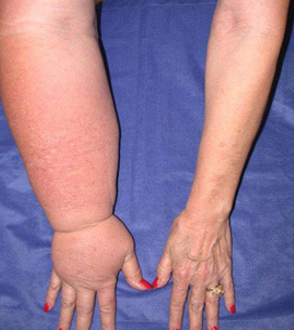Lymphedema is a progressive chronic disease that currently has no cure. The condition develops when the lymphatic system is unable to carry large proteins and lymph fluid away from a region of the body. This painful and disfiguring condition is characterized by gross swelling of the affected limb and caused by a blockage in the lymphatic system, a critical part of the immune and circulatory systems. Untreated, lymphedema can lead to irreversible skin changes, fibrosis, frequent and serious infections, reduced mobility, severe deformity (elephantiasis), resulting in a profound impact on quality of life.
Lymphedema in western countries is most commonly caused by lymph node removal or damage due to cancer treatment. Metastatic tumor cells (particularly breast cancer and melanoma) can frequently spread via the lymphatic vascular system and colonize in lymph nodes, necessitating radical surgery and radiation treatment that often destroys lymphatic vessel networks and leads to impairment of afferent lymphatic flow.
The World Health Organization (WHO) estimates that 15 million patients worldwide suffer from cancer-related lymphedema. It is reported that there are over 150,000 new cases each year in western countries of breast cancer related-lymphedema. Lymphatic filariasis is a far greater global threat. This occurs from a parasitic insect-transmitted infection that is prevalent in tropical regions. The WHO estimated the global burden of filariasis to be 120 million cases, with one third of these patients being incapacitated.

Upper Limb Lymphedema

Lower Limb Lymphedema




